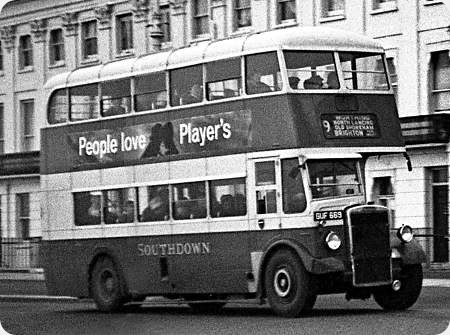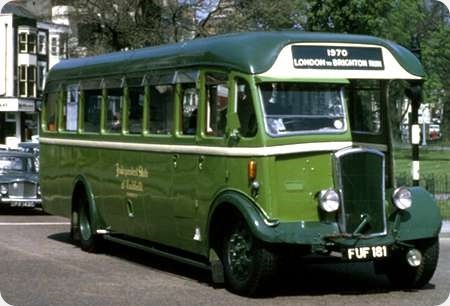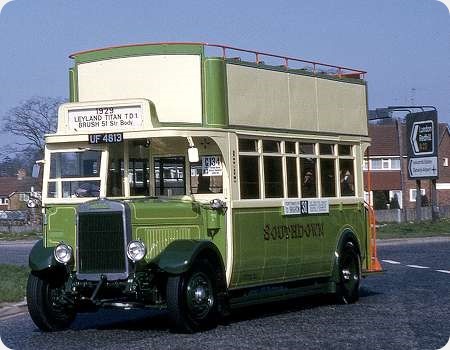Southdown - Leyland Titan PD1 - GUF 669 - 269
Southdown Motor Services
1946
Leyland Titan PD1
Park Royal H26/26R
Taken with my rather primitive Comet S camera in Brighton in 1960, this picture is not one of my best. There were twenty five of these PD1s delivered between June and September 1946, and 269, GUF 669, arrived with Southdown in July. 269 was withdrawn in 1963 and sold to Mexborough and Swinton who upseated it to H32/26R, but withdrew it for scrap just three years later. The PD1, with its 100 bhp 7.4 litre E181 engine and slow gearchange, was never a lively performer, and would have found some of the hills around Brighton to have been a bit of of a challenge, but several were based at Worthing depot, and in the picture 269 is operating along the relatively easy coastal route 9 from Arundel to Brighton.
Photograph and Copy contributed by Roger Cox
01/05/22 - 07:37
Poor photo you might feel, Roger, but photos of immediate post-war buses are often fascinating. I’m not sure I’ve ever seen a Park Royal bodied one before, still five-bay. Weymann ones are seemingly more common. I agree with the painfully slow gearchanges on these vehicles; you could drink a cup of tea between gears, at least you could with London Transport’s austerity TD4 STDs, which sometimes would appear at Raynes Park, on the 77A route! Why they were given challenging routes in Central London and not allocated to Country services, I don’t know. But that’s London Transport for you!
Chris Hebbron
22/05/22 - 06:47
I went on a family holiday to Worthing in 1959, our first Southern holiday. I remember these PD1s from that holiday and this particular bus from its days with Mexborough and Swinton as I worked as an apprentice at Parkgate at that time just along the road from the M&S depot. I don’t recall ever travelling on it or its sibling. They have a certain rugged attraction to the bodywork and certainly dissimilar to any other buses that I came across. Thanks for the memories!!
Ian Wild
24/05/22 - 05:46
Chris, the utility London Transport STD class of 1941/2 comprised eleven ‘unfrozen’ buses of the Leyland TD7 variety, a type that was introduced in succession to the TD5 in 1939. The TD6 was a special Birmingham only gearless version of the TD7, the model number being changed by Leyland for the wider market. In addition to being higher geared than the TD5, a significant change was the adoption of flexible engine mountings, and, to reduce rock, the engine was equipped with a heavier flywheel than before. This, however, resulted in the engine revs taking a long time to die between upward gear changes, which, added to the high gearing, made the TD7 painfully slow on intensive town services. Perversely, the London TD7s were all allocated to Victoria garage where they were regarded with an attitude bordering on hatred, and STD 101-111 were the very first utility buses to be withdrawn from front line service by London Transport. They all went unlamented for scrap. In practice, several provincial operators found that the flexible engine mountings of the TD7 weakened the chassis frame at the back of the engine and restored their examples to the solid mountings of the TD5, so was it all worth it, one wonders. The wartime bus industry is reported to have been utterly dismayed when the Leyland TD8 utility bus option was cancelled by the Ministry of War Transport, leaving only the suspiciously unknown quantity called the Guy Arab available to operators. Perhaps the heavy flywheel TD8 might not have proved popular in practice, whereas the Arab went on to earn a reputation as a truly dependable workhorse. Despite having a rigidly mounted engine the PD1 also precluded remotely speedy gear changes, and Geoffrey Hilditch declared that this model had the slowest gear change he ever encountered, though it seems that he didn’t come across the equally ponderous TD7. Strangely, the single deck PS1 of identical mechanical specification did not seem to earn a similar reputation. No doubt the lighter vehicle weight permitted better forward progress through the gears.
Roger Cox
Quick links to the - Comments Page - Contact Page - Home Page



